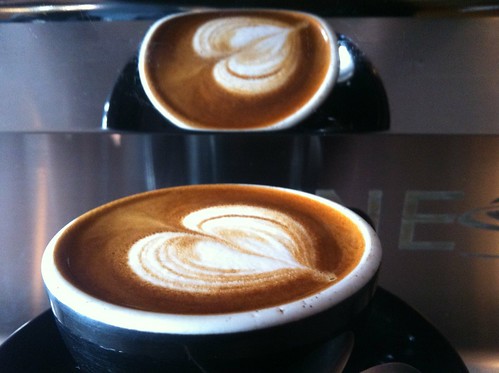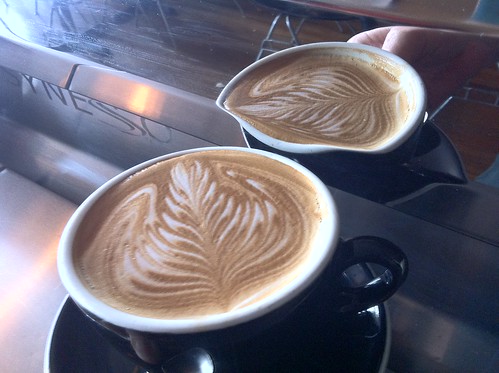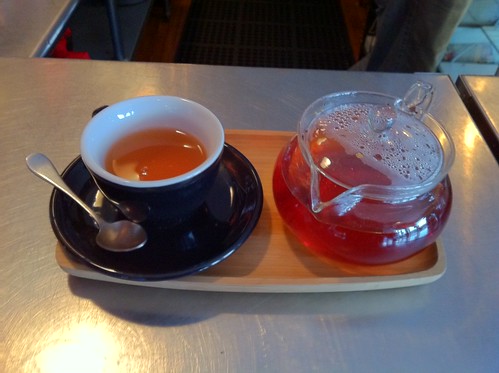
Let’s get this out of the way: like an American football or an Italian political corruption scandal, a macchiato made by a well known chain is not called a macchiato anywhere else. The term ‘macchiato’ means ‘marked’ in Italian, and refers to an espresso with a spritz of foam and nothing else; that’s how Gorilla, and other shops that take coffee seriously do it. The slurry of caramel syrup, milk, and espresso presented at a ubiquitous national chain is only called a macchiato because they were running out of available words for things on their menu.
This presents a problem for us: when somebody asks for a macchiato, do we ask for clarification? Do we prepare our macchiato without asking questions, confident in the knowledge that we’re doing it the right way? We see our fair share of mixups and mishaps surrounding the macchiato problem, and it seems like an inconvenience that’s going to stick around for a while. This is the problem we all have when language is used in a new way; it fosters misunderstanding, whether it’s a teenager in 1985 explaining to her parents that ‘bad’ means ‘good’ or that same person in 2005 explaining to her boss that ‘literally’ means ‘figuratively’.
Ultimately, can we fault the branding goons at bucks for their decision? Sure, they’ve introduced a (probably permanent) division and confusion in what was once a usefully precise term. But without invention in language, we wouldn’t have Shakespeare, Gertrude Stein, or Waka Flocka Flame. And besides, the history of coffee terminology is full of confusion and misdirection: for all that we list and prepare our café au lait and our latte as distinct drinks, the two words mean the same thing in two languages. The difference between our approach and that of the bucks marketing machine is a difference of degree rather than kind. The macchiato problem is inconvenient and frustrating, but for us, as coffee lovers behind an espresso machine, and as humans in the world, it’s the cost of doing business.
Read more +

Florence Fabricant, a nationally renown food writer and columnist who contributes regularly and frequently to the New York Times dining section, loves Gorilla Cold Brew. This is what she had to say about it:
Read more +
Today we did a little experiment where we paired some of our favorite cheeses with one of our favorite coffees, Kintamani, Bali.
Here is what we found…
GABIETOU; RAW COW & SHEEP’S MILK; FRANCE
Cheese notes: hints of cashew and earth with a smooth, spreadable texture.
Paired with the Kintamani, Bali:
The strong strawberry aroma and big jam flavors create a well-rounded dessert pairing. It is a sophisticated cashew butter & jam sandwich. This Kintamani is my Beaujolais.
—–
GOUDA, L’AMUSE; RAW COW’S MILK; 2 YRS; HOLLAND
Cheese notes: nice orange zest punch up front & vanilla on the finish. The texture is dense and dry with protein crystals evenly throughout. The cheese offers a wonderful butterscotch note that is enhanced by the coffee.
Paired with the Kintamani, Bali:
Chocolate is in the forefront when this coffee and cheese meet. The butterscotch notes of this Gouda showcase more as toasted carmel. The combination of the orange & carmel (cheese) matched with strawberry & chocolate (coffee) just make this a lovely pairing. The two match so well that it does not challenge the palate. It is delicious but will not invoke a discussion beyond, “pass me some more, please”.
—–
ADELLEGER; RAW COW’S MILK; BAVARIA
Cheese notes: this cheese has a split personality. The core is sweet with hints of pineapple. The denser cheese near the rind has notes of truffle and earth.
Paired with the Kintamani, Bali:
This is like 2 cheeses in 1. The center of the Adelleger offers delicate refreshing notes of pineapple that pairs well with the strawberry notes of the Kintamani. The coffee lightens when paired with the core of the cheese and offers an almost refreshing experience.
The heavier notes of truffle and earth offered by the rind areas of the cheese brings out a perception of a heavy body to the coffee. The strawberry & jam blend well to create almost a sweet, creamy mushroom experience. Much heavier than the core of the cheese. This is a pairing for those who want to debate! One pairing with two distinct impressions. Very cool.
—–
GORGONZOLA “CREMIFACATO”; COW’S MILK: LOMBARDI, ITALY
Cheese notes: savory and “blue” this cheese is super creamy and dripping off the tip of my knife.
Paired with the Kintamani, Bali:
This cheese changes the most when paired with Kintamani. The coffee softens the sharpness of the cheese and creates a wonderful dessert. Amazing! The palate is brought from sharp, tart, and sour to sweet and creamy. This is an overall winner. The body of the coffee holds up to this stinky cheese. Perception: the cheese gets sweeter paired with the Bali.
Hope you find this helpful. Cheese and coffee and really fun to pair!
Read more +
Been taking pictures of some drinks at the store lately, and wanted to share them here. Espresso-a-Go-Go – CREMA (pictured above).
Macchiato

Latte

Organic Rooibos Tea Service

Read more +
We had an amazingly productive visit with the Pacas Family. We cupped some incredible coffees and got to see some of our favorite farms at the peak for picking. More pictures and videos, hopefully, to come.
Read more +





